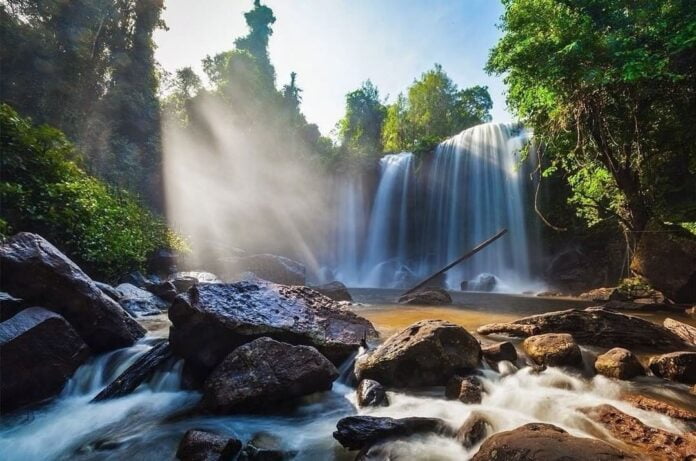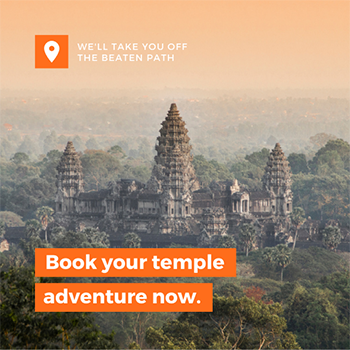One of the most popular attractions in Cambodia is the majestic Phnom Kulen mountain, located about 1.5-2 hours away from Siem Reap. The mountain was given its name due to the abundance of lychee trees it once hosted, and nowadays offers visitors a beautiful view, as well as fun activities such as picnicking and waterfall swimming. For those who plan to drive up to the top of Kulen Mountain, you need to get there early, as the road is one-way traffic only.
Located about 50 kilometers from the city of Siem Reap, Phnom Kulen is one of Cambodia’s most revered sites. According to legend, it was here that King Jayavarman II declared independence from Java in 802 CE and thus began the Khmer Empire – as an independent nation.
Additionally, it’s a very sacred site with multiple temples easily accessible. Two sites most noted are the Thousand Lingas at Kbal Spean, within the Kulen National Park site and Preah Ang Thom pagoda with its giant reclining Buddha. The area is a magnet to “kru khmer” (natural medicine doctors), and attracts people seeking blessings from its holy waters, particularly the potent life-giving waters at Kbal Spean, that are said to help couples conceive.
Admission and Hours
Phnom Kulen is within the Kulen National Park, which requires a separate ticket to the Angkor Archaeological Park. It’s $20 per person if bought at the gate at the entrance to the mountain or you can book your tickets online and have them delivered to your hotel. Cambodians can enter the park for free.
If you’re going to the top of the mountain by car, van or moto, you need to go up before 11am. The road is one-way traffic only and the traffic going up finishes early, so don’t be late!
Etiquette
This is a place where Cambodians go to relax and play. In Cambodian culture most people dress conservatively even whilst swimming, so girls – keep to shorts and t-shirts, boys too – or if you must, at least shorts. No bikinis or speedos please!
When entering temples, be sure to remove your shoes and hats. It’s important to wear clothing that covers you from shoulders to knees. If you are not dressed accordingly, then it would be polite not to enter any of the temples.
How to Get There
Phnom Kulen is 48km from Siem Reap and can take 1.5-2 hours to reach by car or van, longer by tuk tuk but then that will only be if you want to walk up and back down again (approx. 2 hours each way, and absolutely stunning) as tuk tuk’s aren’t capable of making the steep journey to the top.
The ticket office is at the bottom of Phnom Kulen and is the entrance to the Phnom Kulen National Park. It is here that you need to pay for your ticket, if you didn’t buy it online, and show your tickets to go through. There are good toilet facilities here.
From the ticket office, it’s another 20 or so minutes of windy roads until you reach the top, where there are lots of markets selling souvenirs, clothing, snacks and drinks. From here you walk the rest of the way, following the grand staircase up to the pagoda or the lower path that leads to the waterfall and the picnic areas.
If you like hiking and are feeling energetic then the walk from the bottom of the mountain to the top of Phnom Kulen is highly recommended.
To hike up Kulen Mountain, start by taking the large road to the right of the main street that leads to the entrance gate of Phnom Kulen National Park. After about 1km, you will see the entrance gate to Wat Prohm Bram Bey, turn in here and take the stairs at the front. At Wat Prohm Bram Bey, you can choose different paths that will all eventually join up. When you reach Wat Preah Cup, follow the stairs on the right side of the pagoda to explore a natural spring, swimming pool and spirit house. When finished exploring, take the stairs on the left side of the pagoda to reach a dirt path through the jungle. Follow this path for about an hour until you emerge in a small village, and keep walking until you reach the bridge near Kbal Spean. Expect to be asked for your entrance ticket at this point. From there, it’s an easy walk to Wat Preah Ang Thom, Kbal Spean, or the Phnom Kulen waterfalls.
A private taxi / car for the day is around $50 and vans from $60-80. Organized tours including an experienced English speaking guide are available as well. It’s worth booking ahead, as it will save you time when in Siem Reap.
We highly recommend this full-day Kulen waterfall and 1000 Lingas tour, which can easily be booked online with free cancellation up to 24 hours before the tour. You can choose between a shared minibus with guide, private car, private minibus or even an army jeep!
It’s also possible to visit Banteay Srei region on the way back. However if you do wish to see the temples (Banteay Srei and Banteay Samre), you will also need an Angkor pass.
Alternatively, another nice way to complete the day is with a visit to Beng Mealea, only 7 kilometres away from Phnom Kulen. Surrounded by a 1.2 km wide moat, Beng Mealea is a beautiful temple to visit, still engulfed in jungle overgrowth and untouched.
Things to See and Do
Thousand Lingas / Kbal Spean
Kbal Spean is along the way to the top of the mountain and is a serene and gentle place. The 1000 carved lingas in the “Valley of the Lingas” or “River of the Lingas”, as it’s often referred to, are tribute to the Hindu god Shiva. It is a revered spiritual place for Cambodian people and it is said that the water from Kbal Spean will help couples to conceive.
As well as via the main road up the mountain, you can also get to Kbal Spean by walking from ACCB (Angkor Centre for the Conservation of Biodiversity). It’s a 45-minute walk through the jungle.
Waterfall & Picnic Area
The top section of the waterfall is quite flat and good for families or young children that want to dip into the refreshingly cool water. It’s also close to the picnic area, which makes it a really great spot to spend the afternoon ducking in and out of the water. Further down is also a small waterfall; great for timid swimmers and children.
Follow the stairs to get to the lower part of the waterfall which is the main attraction. In wet season, when the waterfall is at its strongest, the sound of the water crashing down is quite something. But it doesn’t stop people from going and experiencing the full force up close! The water isn’t terribly deep and in most sections of the basin of water under the waterfall, you can almost touch the ground. However, best if you can swim and feel confident in the water.
Whilst most people know the connection of Ta Prohm temple and the Lara Croft: Tomb Raider movie, it’s less known that Phnom Kulen waterfall makes a very brief appearance in the film. After escaping living statues in the nether regions of Ta Prohm, Lara runs out to the top of the waterfall (not bad given they are 42kms apart!), where she jumps to the basin below. We wouldn’t recommend it though, it’s unlikely you’d survive a jump like that into relatively shallow water. But they can make all of the magic they like in movies!
Preah Ang Thom
This is the main temple site at Kulen Mountain, it’s important to take off your shoes before entering the temple. There are ladies at the point where you need to relinquish your footwear, don’t worry, they’ll take good care of your shoes for a reasonable fee. Once inside you can make your way up to the giant reclining Buddha statue, reported as the largest in Cambodia, however there are several sitting Buddha’s that dwarf this one. Offering boxes line the length of the Buddha statue and many flowers and other tributes are placed all around.
Srah Damrei
Only accessible by foot, Srah Damrei, or Elephant Pond, is an area filled with stone-carved animals. This ancient Khmer sculpture is also accompanied by a couple of lions and remnants of some other animals. This is a very rewarding sight and worth trekking off the beaten path. There are guides that will be milling around the Preah Ang Thom area, seek one out and they will show you the way.
History
In ancient Khmer, Phnom Kulen was called Mahendraparvata, “Mountain of Indra, the King of the Gods”. It was a thriving city around the size of modern Phnom Penh and the birthplace of the Khmer empire, where King Jayavarman II proclaimed Cambodia’s independence from Java in AD 802. Following this, the capital moved to Roluos (formerly called Hariharalaya).
Though known of by locals, the Kulen’s ancient city was formally rediscovered by explorers in 2012. Starting with a ground expedition and later employing LIDAR technology, Jean-Baptiste Chevance and Damian Evans uncovered Mahendraparvata and several historically important temples, like Prasat O’Paong, which is shaped like a pyramid, with three levels and five towers, similar to those of Angkor Wat.



